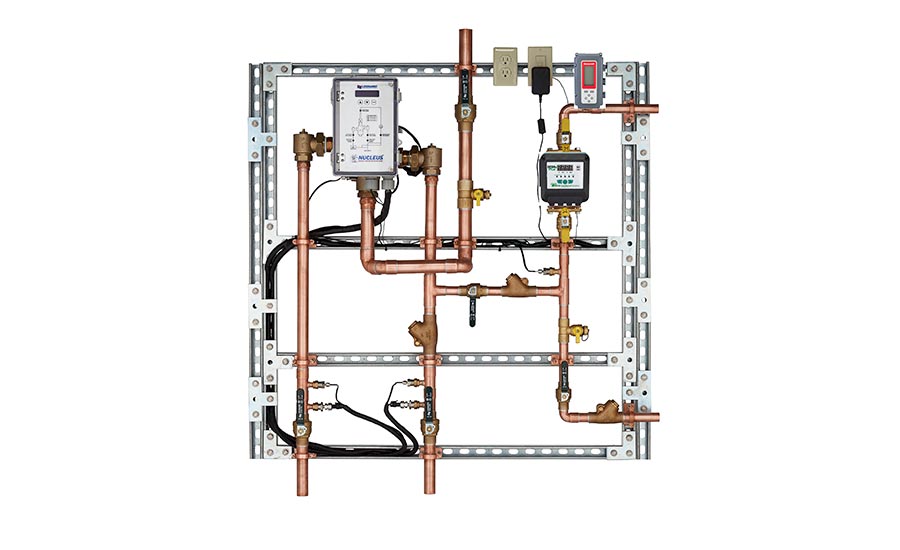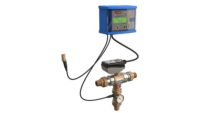There is a revolution happening in today’s plumbing marketplace, specifically when it involves domestic hot water system designs. Manufacturers are supplying today’s better performing digital mixing valves stacked with features and enhancements that carry the capabilities of remote temperature adjustment, high temperature sanitization, building management system integration, multiple temperature and pressure measurement points, flow measurement, self-cleaning, self-monitoring and self-balancing. These features, along with the parallel capabilities and advances in digital smart circulator pumps for these applications, are allowing building designers and specifying engineers to think about the domestic hot water system in ways never previously imagined.
In the past, conventional mixing valve technologies like Bellows, wax or Bi-metal would simply allow the end-user to set the temperature at initial flow condition. These systems allowed no active monitoring of upstream (inlet) or downstream (outlet) temperatures or pressures. The balancing of the recirculation system was accomplished by an iterative process of manually throttling a return ball valve or circuit balancing valve on the return line based on a fixed temperature loss in the system. Typically, in these systems, it would take multiple iterations over a period of days to stabilize system temperatures under pure circulation. If system conditions experienced even slight variations in temperatures or pressures, facility managers were faced with reactionary tactics in the face of no active feedback loops or data that could be served up from the device.
Today, as a direct result of the stacked features within digital mixing valve offerings, there is an active shift from reactive to proactive management of the domestic hot water system. This is now allowing facility managers a complete transformation of thought process where previously the master mixing valve was thought of as a “high maintenance device, the enemy” into thoughts of “with digital mixing valves combined with energy efficient smart pumps, we can change the game.” Simply put, feature packed digital mixing valves provide the vehicle to an ultra-safe and efficient domestic hot water system design.
How feature-packed digital mixing valves can help
There are several frameworks within which to operate when choosing the applicable path to domestic hot water system design depending on the specific application. The discussion below is not, by any means, comprehensive, but rather hopes to illustrate how today’s feature-packed digital mixing valves can help a system designer or specifying engineer achieve mutual outcomes of enhanced domestic hot water safety while satisfying an established standards directive.
VHA Directive 1061
As of Feb. 16, the Department of Veterans Affairs has issued a Transmittal Sheet with updates to the Veterans Health Administration directive that addresses, “The prevention of health care-associated Legionella disease and scald injury from water systems in VHA buildings in which patients, residents or visitors stay overnight; in VHA buildings where employees are required to sleep overnight; and for the management of select outdoor non-potable water systems.”
Within the above, there are engineering control strategies for ongoing prevention of Legionella growth, the deadly bacteria responsible for Legionnaire’s Disease. Specifically, for incoming potable water, the pressure and temperature must be monitored in addition to measurement at water storage tanks, discharge from hot water source equipment, water at the return of circulation loops and water supplied to representative areas of the building (i.e. risers). The directive also stipulates the data must be reviewed weekly at minimum.

The Leonard Nucleus has capabilities for up to 8 points of temperature measurement, 3 points of pressure measurement and 2 points of flow measurement rates within the domestic hot water system. All of these points along with several others can be served up to the building management system and monitored in real-time. Photo courtesy of Leonard Valve.
Questions answered
Q: If the digital mixing valve is monitoring temperatures and pressures at the mixing valve inlets, how could one also measure incoming potable water temperature and pressure and measure all the additional points stipulated above?
A: With a digital mixing valve, the primary valve offering allows four temperature measurement points and two pressure measurement points. With the addition of a simple plug-in expansion card one can now measure an additional four temperature points and an additional pressure measurement point. All of these points can be served up to a building management system directly with the on-board BacNET Testing Laboratories approved Protocol card with 6 standard industry recognized protocols, and they can be viewed real-time at any time with the ability to allow user input alarm highs and lows. This allows for easy real-time access to key facility data points that hinge on compliance and pivot the safety manager’s perspective to risk averse from previously available technologies.
ANSI/ASHRAE Standard 188-2015: Legionellosis Risk Management for Building Water Systems states: “Legionella, a gram negative bacteria, can cause pneumonia which results in Legionnaires’ Disease. It can also cause a less-severe influenza type illness known as “Pontiac Fever.” The Centers for Disease Control and Prevention (CDC) estimates that more than 10% of the documented 8,000 to 18,000 cases in the United States are fatal. Most cases are the result of exposure to Legionella bacteria associated with building water systems.”
The above standard applies to human-occupied commercial, institutional, multiunit residential and industrial buildings. It is intended for those involved in the design, construction, installation, commissioning, operation, maintenance and service of centralized building water systems and components.
At the heart of minimizing the risk associated with Legionella, this program works to establish a water management program that is inclusive of a program team, a description of the water systems in the building, an evaluation of hazards or analysis, establishing control measures and how they are applied, monitoring corrective actions, confirming that the program is being implemented and establishing relevant documentation. As one reads through the entire written standard, two common themes are prevalent: “Monitoring” of water temperatures and “disinfection” at multiple levels.
Q: Can I monitor and disinfect with a digital mixing valve to try and achieve compliance with Standard 188?
A: Absolutely! The majority of digital mixing valves offered today allow some degree of monitoring as well as a hot water sanitization feature, which will allow for disinfection by high temperature hot water.
In addition, some digital mixing valves allow each user to input high and low level alarms to trigger alarm conditions that instantly notify appropriate personnel if something is out of specification or tolerance. The ability to disinfect the entire domestic hot water system with minimum 158° F hot water also comes standard on the some systems. The programming is key code protected and involves multiple levels of decision-making in the logic before allowing safe engagement in the process. It is programmable up to 12 hours of Sanitization and can be done locally at the keypad or remotely through the building management system.
The disinfection cycle is continuously monitored and will automatically drop out of cycle and alert the user should temperatures be above or below expectant values. Previously not possible with conventional mixing valves, digital mixing valves continue to inject a safer value proposition to key facility managers and decision makers and re-invent domestic hot water systems.
Safety in design
As feature-packed digital mixing valves now shine a brighter light on these systems we must recognize that they are the single most important safety device in a properly designed domestic hot water system, as they are intended to lower the outlet temperature being fed from the hot water source to a safe, useable level; one which prevents burns, thermal shock, or scalding of end users of downstream devices.
It is fact that hot water at 140°F causes a first-degree burn in just two seconds, and causes second and third-degree burns in just five seconds. This cannot be ignored in applications where bathers and end-users are either young children or elderly who may not be able to remove themselves from the water stream.
It is a delicate balance when trying to solve both the Legionellae issue and the risk of thermal shock in a domestic hot water system. The solution that makes most sense is the one that addresses both issues head-on. Ideally, one would store hot water at a minimum of 140°F, which kills the potentially deadly Legionellae bacteria within 32 minutes, and then install a digital mixing valve downstream of the hot water source which would then allow temperatures to be reduced to safe levels below 120°F.
There are two key aspects of a properly designed system. The first is to minimize water flow stagnation in the system by designing a proper circulating loop. The second is to bring a portion of the domestic hot water back to the heat source so there always exists some “sanitization effect” where the bacteria can be killed at the 140°F or more source temperature. Today’s energy efficient smart pumps like Taco Comfort Solutions’ 0034e provide the designer or specifying engineer many options to achieve better performing, safer recirculation systems.
Master mixing valves are evolving in an effort to help alleviate design concerns regarding these issues. Digital master mixing valves are now filled with design features such as cloud based logging and monitoring of all critical system data with the ability to send alerts for any temperatures that may fall “out of range”. This allows for quick response and resolution of issues. These valves also now have programming capabilities to create safe disinfection cycles and kill the bacteria throughout the entire domestic hot water system.
These valves are the perfect vehicle to solve both the deadly Legionella issue while simultaneously protecting end users from burns, scalds and thermal shock. Add in the supplied features of self-cleaning, self-monitoring and self-balancing and maintenance and installation of these devices is a breeze. Simply put, digital mixing valves packed with features are our future, and are a key “cog in the wheel” to ultra-safe hot water system design and distribution.



